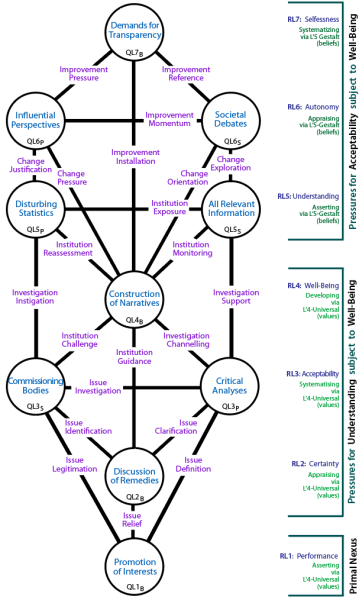Psychosocial Pressures in Institutions
3 Tiers
There are three tiers of pressure affecting Centres in the Tree: all of which are shown in the diagram on the right—mouse-over to enlarge.
The first tier and overarching psychosocial pressure for is well-being, and so this must apply to all Levels/Centres. This pressure does not assist with clarifying the internal Tree structure but provides an insight to the way all Centre functioning is driven.
See rationale for this pressure assignment here.
The second tier is the psychosocial pressure intrinsic to the two that originate this Q4 Arena as explained earlier.
Centres in L's 1-4 derive from which is subject to an understanding pressure.
Centres in L's 5-7 derive from which is subject to an acceptability pressure.

See analysis of pressure assignments in the Architecture Room.
The third tier emerges from the Tree structure. This is a standard arrangement in which each level is aligned with pressures in the corresponding levels in the Root Hierarchy. The influence of this pressure will be discussed Level by Level.
See more here.
Third Tier
L1 Pressure
The psychosocial pressure in L1 is Performance, which relates to the promtional activity required to bring the interest, need, demand, concern or complaint to public attention.
L2 Pressure
The psychosocial pressure in L2 is Certainty, which shows up in the choice of an «obvious» solution, like "more money" or "more staff". Certainty underpins the necessary confidence to campaign and lobby.
L3 Pressure
At L3, Acceptability is the operative pressure and this may either inhibit or generate bias. The writer of any commissioned report will be inclined to ensure that his analysis is welcomed, published and not censored. Even a fully independent investigator will avoid criticizing cultural assumptions and conventions. If any investigation exposes malfeasance of powerful bodies, these entities may discredit the author or find ways to bury the report. Sometimes a more acceptable alternative report may be commissioned to muddy the waters by reaching opposing conclusions.
L4 Pressure
At L4, the psychosocial pressure is Well-Being, reinforcing the overarching Well-Being pressure. This is likely why societal leaders are preoccupied with soothing and encouraging the general public. Even if the narrative is dealing with an extremely unpleasant social reality, it is phrased to provide hope and the expectation and even prediction of better times to follow.
L5 Pressure
The L5 psychosocial pressure is Understanding, which relates to both handling data and what the public can grasp. Statistics and their meaning are intrinsically problematic, involving abstraction, a continually varying context of collection and recording, and issues of validity and reliability.
L6 Pressure
At L6, there is psychosocial pressure for Autonomy. Questioning in public debates requires individuals to present and defend their preferred perspective or theory. However, they feel entitled to maintain secrecy and pursue private agendas. This pressure, likely applies to those responsible for orchestrating and chairing such events as well.
L7 Pressure
The psychosocial pressure for L7 is Selflessness, which is the very opposite of vested interest concerns. That is why impartiality and independence is so essential when compulsion is used to access documentation that would normally be treated as privileged or confidential.
Continue to the final section of this investigation into institutional evolution and public consent by:
- understanding how evolution is guided by people, which is revealed in the ,
and then: - how we can get engaged with that evolution in a constructive way, which is revealed by the .
Originally posted: 28-Mar-2023.